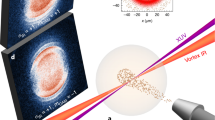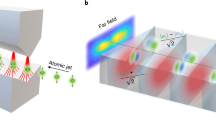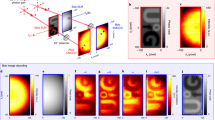Abstract
The electro-optic effect, where the refractive index of a medium is modified by an electric field, is of central importance in nonlinear optics, laser technology, quantum optics and optical communications. In general, electro-optic coefficients are very weak and a medium with a giant electro-optic coefficient could have profound implications for precision electrometry and nonlinear optics at the single-photon level. Here we propose and demonstrate a giant d.c. electro-optic effect on the basis of polarizable (Rydberg) dark states. When a medium is prepared in a dark state consisting of a superposition of ground and Rydberg energy levels, it becomes transparent and acquires a refractive index that is dependent on the energy of the highly polarizable Rydberg state. We demonstrate phase modulation of the light field in the Rydberg-dark-state medium and measure an electro-optic coefficient that is more than six orders of magnitude larger than in usual Kerr media.
This is a preview of subscription content, access via your institution
Access options
Subscribe to this journal
Receive 12 print issues and online access
$209.00 per year
only $17.42 per issue
Buy this article
- Purchase on Springer Link
- Instant access to full article PDF
Prices may be subject to local taxes which are calculated during checkout




Similar content being viewed by others
References
Kerr, J. A new relation between electricity and light: Dielectric media birefrigent. Phil. Mag. 50, 337–348 (1875).
Yariv, A. Quantum Electronics 3rd edn, Ch. 14 (Wiley, 1988).
Boyd, R. W. Non-Linear Optics 2nd edn, Ch. 11 (Academic, 2003).
Spence, D. E., Kean, P. N. & Sibbett, W. 60-fsec pulse generation from a self-mode-locked Ti:sapphire laser. Opt. Lett. 16, 42–45 (1991).
Brabec, T. & Krausz, F. Intense few-cycle laser fields: Frontiers of nonlinear optics. Rev. Mod. Phys. 72, 545–591 (2000).
Boller, K.-J., Imamoğlu, A. & Harris, S. E. Observation of electromagnetically induced transparency. Phys. Rev. Lett. 66, 2593–2596 (1991).
Kasapi, A., Jain, M., Yin, G. Y. & Harris, S. E. Electromagnetically induced transparency: Propagation dynamics. Phys. Rev. Lett. 74, 2447–2450 (1995).
Fleischhauer, M., Imamoglu, A. & Marangos, J. P. Electromagnetically induced transparency: Optics in coherent media. Rev. Mod. Phys. 77, 633–673 (2005).
Harris, S. E., Field, J. E. & Imamoğlu, A. Nonlinear optical processes using electromagnetically induced transparency. Phys. Rev. Lett. 64, 1107–1110 (1990).
Schmidt, H. & Imamoğlu, A. Giant Kerr nonlinearities obtained by electromagnetically induced transparency. Opt. Lett. 21, 1936–1938 (1996).
Hau, L. V., Harris, S. E., Dutton, Z. & Behroozi, C. H. Light speed reduction to 17 m per second in an ultracold atomic gas. Nature 397, 594–598 (1999).
Kang, H. & Zhu, Y. Observation of large Kerr nonlinearity at low light intensities. Phys. Rev. Lett. 91, 093601 (2003).
Chuang, I. L. & Yamamoto, Y. Simple quantum computer. Phys. Rev. A 52, 3489–3496 (1995).
Shapiro, J. H. Single-photon Kerr nonlinearities do not help quantum computation. Phys. Rev. A 73, 062305 (2006).
Friedler, I., Petrosyan, D., Fleischhauer, M. & Kurizki, G. Long range interactions and entanglement of slow single-photon pulses. Phys. Rev. A 72, 043803 (2005).
Gallagher, T. F. Rydberg Atoms Ch. 2 (Cambridge Univ. Press, 1994).
Mohapatra, A. K., Jackson, T. R. & Adams, C. S. Coherent optical detection of highly excited Rydberg states using electromagnetically induced transparency. Phys. Rev. Lett. 98, 113003 (2007).
Mauger, S., Millen, J. & Jones, M. P. A. Spectroscopy of strontium Rydberg states using electromagnetically induced transparency. J. Phys. B 40, F319–F325 (2007).
Lukin, M. D. et al. Dipole blockade and quantum information processing in mesoscopic atomic ensembles. Phys. Rev. Lett. 87, 037901 (2001).
Jaksch, D. et al. Fast quantum gates for neutral atoms. Phys. Rev. Lett. 85, 2208–2211 (2000).
Tong, D. et al. Local blockade of Rydberg excitation in an ultracold gas. Phys. Rev. Lett. 93, 063001 (2004).
Singer, K., Reetz-Lamour, M., Amthor, T., Marcassa, L. G. & Weidemüller, M. Supression of excitation and spectral broadening induced by interactions in a cold gas of Rydberg atoms. Phys. Rev. Lett. 93, 163001 (2004).
Cubel Liebisch, T., Reinhard, A., Berman, P. R. & Raithel, G. Atom counting statistics in ensembles of interacting Rydberg atoms. Phys. Rev. Lett. 95, 253002 (2005).
Vogt, T. et al. Dipole blockade at Förster resonances in high resolution laser excitation of Rydberg states of cesium atoms. Phys. Rev. Lett. 97, 083003 (2006).
Heidemann, R. et al. Evidence for coherent collective Rydberg excitation in the strong blockade regime. Phys. Rev. Lett. 99, 163601 (2007).
Weatherill, K. J., Pritchard, J. D., Bason, M. G., Mohapatra, A. K. & Adams, C. S. Electromagnetically induced transparency of an interacting cold Rydberg ensemble. J. Phys. B (in the press); preprint at <http://arxiv.org/abs/0805.4327> (2008).
Low, R. et al. Apparatus for excitation and detection of Rydberg atoms in quantum gases. Preprint at <http://arxiv.org/abs/0706.2639> (2007).
Li, W., Mourachko, I., Noel, M. W. & Gallagher, T. F. Millimeter-wave spectroscopy of cold rubidium Rydberg atoms in magneto-optical trap: Quantum defects for the ns, np, and nd series. Phys. Rev. A 67, 052502 (2003).
Chen, Y.-F., Liu, Y.-C., Tsai, Z.-H., Wang, S.-H. & Yu, I. A. Beat-note interferometer for direct phase measurement of photonic information. Phys. Rev. A 72, 033812 (2005).
Li, Y. & Xiao, M. Transient properties of an electromagnetically induced transparency in three-level atoms. Opt. Lett. 20, 1489–1491 (1995).
Chen, H. X., Durrant, A. V., Marangos, J. P. & Vaccaro, J. A. Observation of transient electromagnetically induced transparency in rubidium Λ system. Phys. Rev. A 58, 1545–1548 (1998).
Shah, V., Knappe, S., Schwindt, P. D. D. & Kitching, J. Subpicotesla atomic magnetometry with a microfabricated vapour cell. Nature Photon. 1, 649–652 (2007).
Gea-Banacloche, J., Li, Y., Jin, S. & Xiao, M. Electromagnetically induced transparency in ladder-type inhomogeneously broadened media: Theory and experiment. Phys. Rev. A 51, 576–584 (1995).
Pearman, C. P. et al. Polarization spectroscopy of a closed atomic transition: Application to laser frequency locking. J. Phys. B 35, 5141–5151 (2002).
Inbar, E. & Arie, A. High sensitivity measurements of the Kerr constants in gases using a Fabry-Pèrot-based ellipsometer. Appl. Phys. B 70, 849–852 (2000).
Webber, M. J. (ed.) Handbook of Optical Materials Ch. 2,5 (CRC Press, 2003).
Acknowledgements
We are grateful to E. Riis, T. Pfau, M. P. A. Jones, S. L. Cornish and I. G. Hughes for stimulating discussions, R. P. Abel for technical assistance and S. L. Cornish for loan of equipment. We thank the EPSRC for financial support.
Author information
Authors and Affiliations
Contributions
A.K.M. and C.S.A. contributed to project planning and data analysis, M.G.B., B.B., K.J.W. and A.K.M. contributed to experimental work, M.G.B., A.K.M. and C.S.A. contributed to theoretical modelling and all authors contributed to writing and editing the manuscript.
Corresponding authors
Rights and permissions
About this article
Cite this article
Mohapatra, A., Bason, M., Butscher, B. et al. A giant electro-optic effect using polarizable dark states. Nature Phys 4, 890–894 (2008). https://doi.org/10.1038/nphys1091
Received:
Accepted:
Published:
Issue Date:
DOI: https://doi.org/10.1038/nphys1091
This article is cited by
-
Population Distribution and Splitting Nonlinearity for Rydberg Atomic Gas under Multiple Fields
Journal of Russian Laser Research (2024)
-
Atomic superheterodyne receiver based on microwave-dressed Rydberg spectroscopy
Nature Physics (2020)
-
Optical transparency and nonlinearity for a five-level tripod system involving a Rydberg state
Optical and Quantum Electronics (2020)
-
High-sensitivity measurement of Rydberg population via two-photon excitation in atomic vapour using optical heterodyne detection technique
Pramana (2019)
-
Rydberg interaction induced enhanced excitation in thermal atomic vapor
Scientific Reports (2018)



